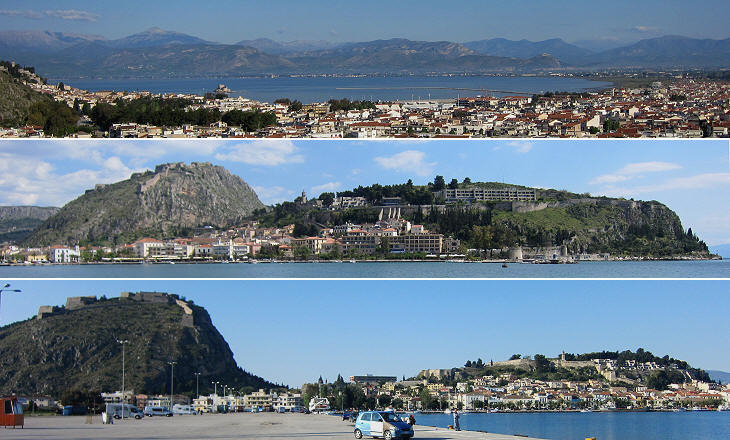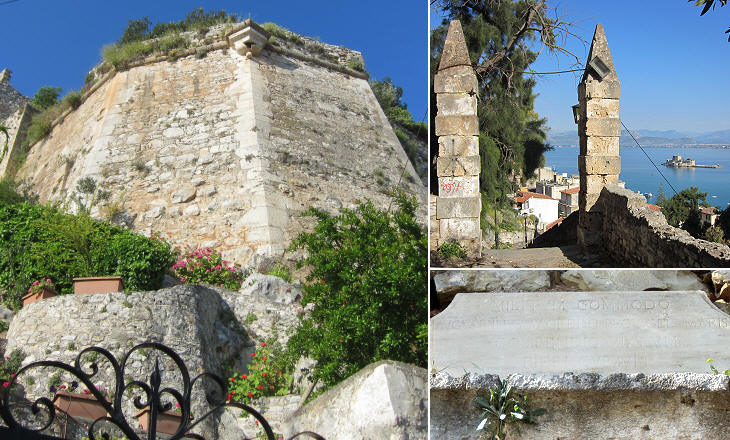  What's New! Detailed Sitemap All images © by Roberto Piperno, owner of the domain. Write to romapip@quipo.it. Text edited by Rosamie Moore. Page revised in October 2011. |
  Napoli di Romania (Nauplia/Nafplio) Napoli di Romania (Nauplia/Nafplio)
According to tradition Nauplia was founded by Nauplius, a son of Poseidon, the Greek god of the sea, on a short promontory at the eastern end of the Argolic Gulf (aka Gulf of Nauplia). Argolis is the region of northern Peloponnese where the Mycenean civilization developed between 1600 and 1100 BC. Palamidi, a large rocky hill to the east of Nauplia, is named after Palamedes, a son of another Nauplius, king of Nauplia, who participated in the Trojan War. Palamedes lost his life in the war; he was not killed by a Trojan but by Odysseus (Ulysses) who reproached him for having revealed his trick for not going to war (Odysseus had pretended to be insane).
Acronauplia
After the 1204 conquest of Constantinople by the Frank knights leading the Fourth Crusade, Argos and Nauplia were assigned to Othon de la Roche; the fiefdom was eventually acquired by the Enghien family until it was sold to Venice in 1388. At that time the town was located on the promontory and it was protected by walls built by the Byzantines (Castel de' Greci in Venetian accounts) and enlarged by the de la Roche/Enghien (Castel de' Franchi).
The decision to buy Nauplia had the objective of protecting the activity of Venetian merchants; their presence at Nauplia was established as early as the end of the XIth century as a consequence of an edict by Emperor Alexius I Comnenos issued in 1082 by which Venice was granted access to all Byzantine ports; this in return for the Republic's help in protecting the Empire from the attacks of Robert Guiscard, the founder of a Norman kingdom in southern Italy and Sicily.
At the time of the Venetian acquisition of Nauplia the Byzantines were gradually taking control of the whole of the Peloponnese to the detriment of the remaining Frank fiefdoms. They established a Despotate of Morea (Peloponnese) which was only formally a part of the Byzantine Empire and which at least initially was able to cope with the growing Ottoman threat.
For some time after having acquired Nauplia, the Venetians did not bother about fortifying it, but after Sultan Mehmet II conquered Constantinople in 1453, they realized that the Ottomans were a real threat to their possessions; more so after the Ottomans conquered Mistra (1460), the capital of the Despotate of Morea and Negroponte (1469), an island held by the Venetians since 1204.
New fortifications including a circular bastion (Castel del Toro o Torrione) were built to the east of the existing ones; all walls of the previous fortifications were maintained so that the town was partitioned into three separately defensible sections. In 1499 the Ottomans waged war on Venice; they conquered Lepanto, Navarino, Corone and other fortresses, but not Nauplia and when eventually a peace agreement was signed in 1502, the Venetians were able to retain the town.
The new fortifications proved again their effectiveness in 1537 when the Ottomans vainly attempted to seize Nauplia and Malvasia which were the only parts of Peloponnese not in Ottoman hands; in 1538 however a Christian fleet was routed near Preveza and the Venetian Senate decided to reach a peace agreement with Sultan Suleyman I. In 1540 Alvise Badoer, a special envoy, was sent to Constantinople to negotiate a truce and eventually a lasting agreement; he was given latitude to surrender Nauplia and Malvasia "as a last resort".
Badoer soon realized that the Ottomans were determined to obtain the two fortresses; he embarked upon lengthy negotiations in the hope of modifying the Ottoman position, but eventually he gave up and the Sultan obtained what his troops had been unable to conquer in the battlefield. It was eventually discovered that the Ottoman obstinacy in wanting the two fortresses was due to the fact that they knew about Badoer's mandate; the information was passed to them by the French ambassador to Venice who learnt it from his sources inside the Council of Ten, the major governing body of the Republic.
During the Ottoman rule the importance of Nauplia as a commercial port declined while it remained a safe haven for the Ottoman fleet; in 1686 the Venetians, led by Francesco Morosini, the former commander of Candia, after having seized the southern part of Peloponnese, attacked Nauplia; the fortifications provided the defenders with a great advantage, but after an Ottoman counterattack was easily repelled by the Venetian musketry, they surrendered.
The Venetians brought with them cannon with a very elaborate decoration which shows the skill of their foundries; all this attention to winged lions, coats of arms, laurel wreaths and flying angels was indicative of a tendency to turn away from the fact that the might of Venice was declining. Some of the cannon on display at Nauplia were cast in the foundry of the Alberghetto; they were a veritable dynasty of bronze-workers and they are mentioned in Venetian records as early as 1498; in 1514 they were involved in casting parts of the monument to Cardinal Battista Zeno in S. Marco in Venice (see a detail in a separate window); the Alberghetto foundry continued to work for the Venetian Republic until its end in 1797 because in 1792 a member of the family was appointed chief founder. GBAF most likely stands for "Giovanni Battista Alberghetto Fonditore". For another example of Italian cannon turned into a work of art you may wish to see Cannone di S. Paolo (in a separate window) at Museo del Bargello in Florence.
The Venetians decided to make Nauplia the capital of the Kingdom of Morea as they called the Peloponnese; they felt the medieval settlement of Acronauplia was unfit for this new role and they relocated its inhabitants to a newly designed town near the harbour.
The fortifications of Acronauplia were not particularly strengthened by the Venetians after they reconquered the town because they focussed their attention on building a new state-of-the-art fortress on Palamidi. Bourtzi or Castel da Mar (Sea Castle)
The name Bourtzi derives from burç, a Turkish word meaning tower (Uzuncaburç = tall tower) and it is used to indicate isolated fortifications; in Greece there are bourtzi at Modoni, Skiathos and other locations, but the best known bourtzi is that of Nauplia.
The small fortress was designed by Antonio Gambello, an architect from Bergamo, in 1471; initially it was made up of a single tower; bastions were added later on, giving it the ship-like appearance it has today. It was further strengthened by the Ottomans who closed the entrance to the harbour by laying a chain from Bourtzi to the pier.
Move to page two: Palamidi and the Venetian/Ottoman/Greek town Excerpts from Memorie Istoriografiche del Regno della Morea Riacquistato dall'armi della Sereniss. Repubblica di Venezia printed in Venice in 1692 and related to this page:
Introductory page on the Venetian Fortresses Pages of this section: On the Ionian Islands: Corfù (Kerkyra) Paxo (Paxi) Santa Maura (Lefkadas) Cefalonia (Kephallonia) Asso (Assos) Itaca (Ithaki) Zante (Zachintos) Cerigo (Kythera) On the mainland: Butrinto (Butrint) Parga Preveza and Azio (Aktion) Vonizza (Vonitsa) Lepanto (Nafpaktos) Atene (Athens) On Morea: Castel di Morea (Rio), Castel di Rumelia (Antirio) and Patrasso (Patra) Castel Tornese (Hlemoutsi) and Glarenza Navarino (Pilo) and Calamata Modon (Methoni) Corone (Koroni) Braccio di Maina, Zarnata, Passavà and Chielefà Mistrà Corinto (Korinthos) Argo (Argos) Napoli di Romania (Nafplio) Malvasia (Monemvassia) On the Aegean Sea: Negroponte (Chalki) Castelrosso (Karistos) Oreo Lemno (Limnos) Schiatto (Skiathos) Scopello (Skopelos) Alonisso Schiro (Skyros) Andro (Andros) Tino (Tinos) Micono (Mykonos) Siro (Syros) Egina (Aegina) Spezzia (Spetse) Paris (Paros) Antiparis (Andiparos) Nasso (Naxos) Serifo (Serifos) Sifno (Syphnos) Milo (Milos) Argentiera (Kimolos) Santorino (Thira) Folegandro (Folegandros) Stampalia (Astipalea) Candia (Kriti) You may refresh your knowledge of the history of Venice in the Levant by reading an abstract from the History of Venice by Thomas Salmon, published in 1754. The Italian text is accompanied by an English summary. Clickable Map of the Ionian and Aegean Seas with links to the Venetian fortresses and to other locations (opens in a separate window) |















